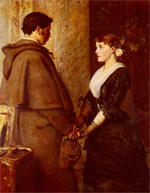
What Is Love?
"'[I]t is right, her instinct told her; right to expose onself
without reservations to other human beings" (287).
Points for Reflection
chps. 15-25
- What drives Ralph’s changing perspective concerning Mary during his visit to Disham (190-98)? Does he see her more clearly than before, or less clearly? To what degree is his depression and memory of Katharine’s inaccessibility a factor? What process of discovery is going on inside Ralph, and is this a journey towards truth or fantasy?
- Recall the formative influence Mary Datchet has had on Ralph’s sense of himself and his ideologies in the past (130-32). Does she continue to demonstrate such powerful influence over his life in this week’s reading?
- In a letter to her sister-in-law Mrs. Milvain, shared in chapter twelve, Mrs. Hilbery noted that Katharine naturally commands and lacks nervousness, traits which obviously separate her from her fiancé William (147). As their engagement plays out in this week’s reading, does Katharine indeed rule, and William follow?
- In chapter nineteen, Mary finds herself unable to clearly delineate the good from the bad in the way she used to (269), a practical bit of polarizing which her fellow suffragette Mrs. Seal has no problem continuing to perform (275). Does Woolf encourage the reader to believe that such distinctions between good and bad as those made by the suffragette movement are silly and meaningless?
- Is the transformation undergone by Mary in chapters eighteen and nineteen, in which she looks directly at what appears to be the “truth” of her circumstances and abandons hope for “happiness” and what is “best” in life (271, 277), meant to be read as either heroic or tragic?
- Katharine reflects during a conversation with Mary that “She [Katharine] was in the habit of assuming . . . that she was rather unobservant of the finer shades of feeling . . . that she was a practical, abstract-minded person, better fitted to deal with figures than with the feelings of men and women,” and concludes with the caveat, “Anyhow, William Rodney would say so” (286-87). Is Rodney’s evaluation of Katharine correct? Is she constitutionally unable to deal with others’ feelings?
- Does today's reading support Mary’s conclusion that “it is right . . . to expose oneself without reservations to other human beings” (287)?
- How does the reader reconcile Ralph’s thoughts of Katharine as “‘the most beautiful, the truest thing in the world’” (311) with his claim that he is not in love with her (312)? Explore the complicated contours of his feelings for Katharine.
- What is it that Ralph has “lost” in speaking so openly and vulnerably with Katharine (317)?
- Katharine’s mathematical impulse—her desire to draw personal problems or reduce them to figures—continues to pop up across this week’s reading (321, 329, 330-31, 348, 350, etc.) Does this approach help her make sense of life’s questions?
- Can one perform a pseudo-psychoanalytic reading of Katharine’s character—as revealed thus far—using the following comment from early in the novel as a starting point? “‘Don’t you see how many different things these people care about? And I want to beat them down—I only mean’, she corrected herself, ‘that I want to assert myself, and it’s difficult, if one hasn’t a profession’” (56).

Yes
John Everett Millais
Dr. Paul
Marchbanks
pmarchba@calpoly.edu
![]()
